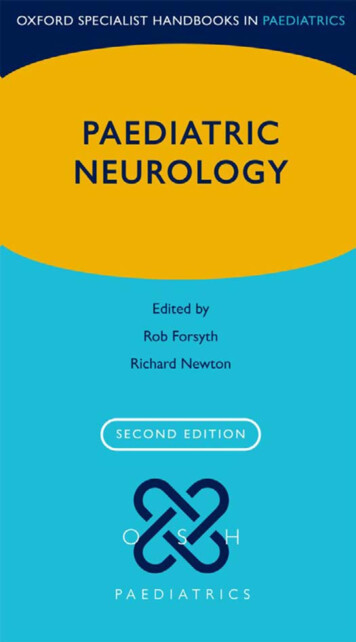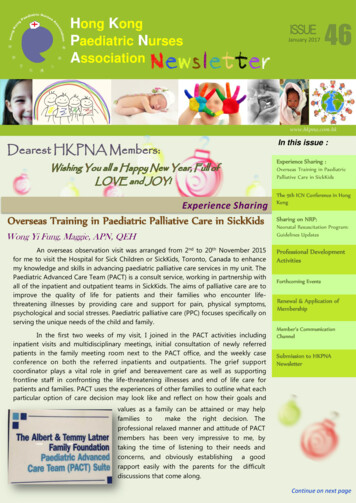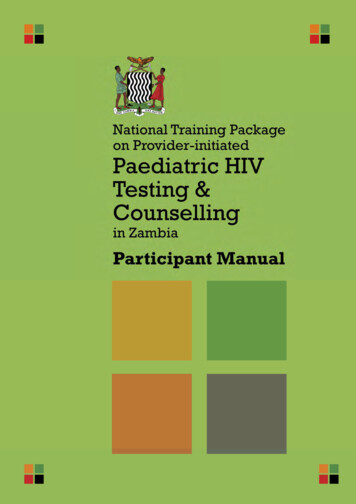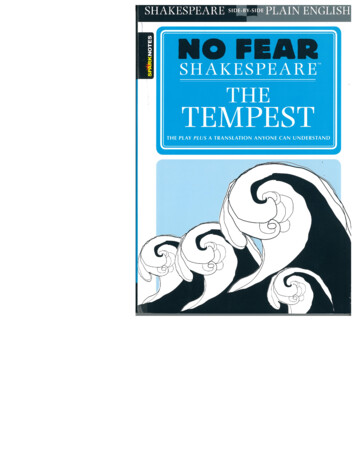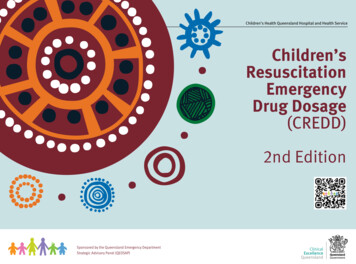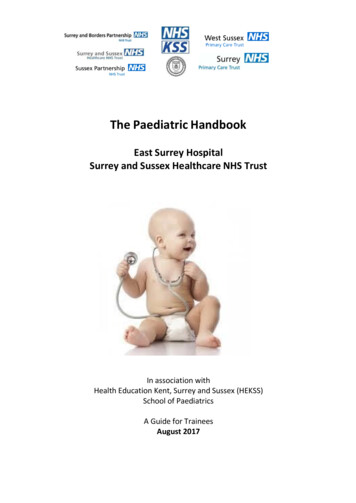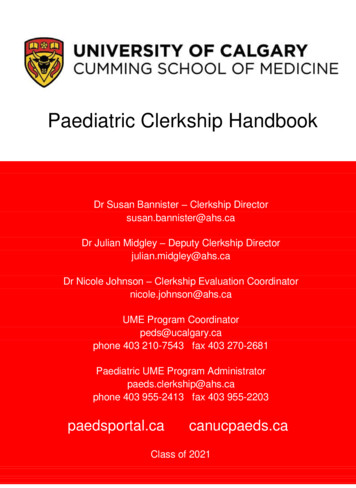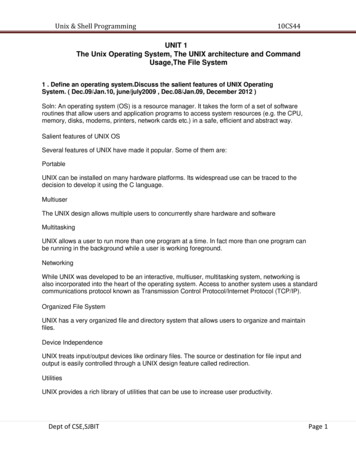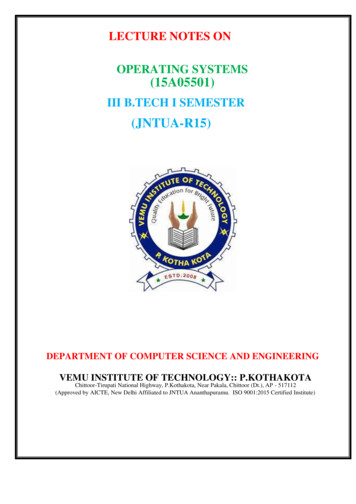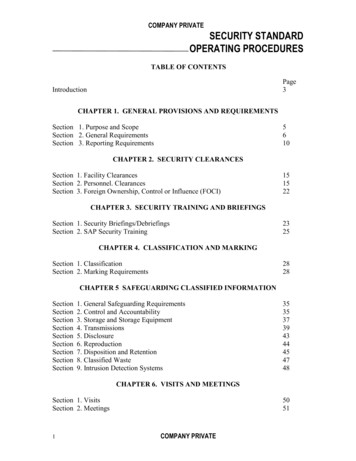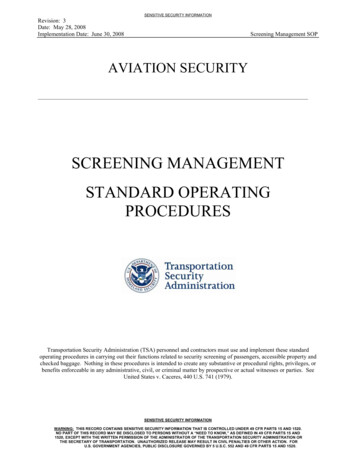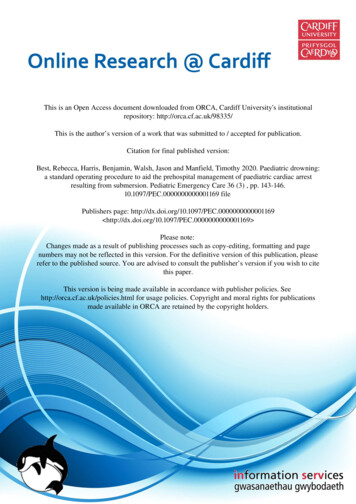
Transcription
This is an Open Access document downloaded from ORCA, Cardiff University's institutionalrepository: http://orca.cf.ac.uk/98335/This is the author’s version of a work that was submitted to / accepted for publication.Citation for final published version:Best, Rebecca, Harris, Benjamin, Walsh, Jason and Manfield, Timothy 2020. Paediatric drowning:a standard operating procedure to aid the prehospital management of paediatric cardiac arrestresulting from submersion. Pediatric Emergency Care 36 (3) , pp. 143-146.10.1097/PEC.0000000000001169 filePublishers page: http://dx.doi.org/10.1097/PEC.0000000000001169 http://dx.doi.org/10.1097/PEC.0000000000001169 Please note:Changes made as a result of publishing processes such as copy-editing, formatting and pagenumbers may not be reflected in this version. For the definitive version of this publication, pleaserefer to the published source. You are advised to consult the publisher’s version if you wish to citethis paper.This version is being made available in accordance with publisher policies. Seehttp://orca.cf.ac.uk/policies.html for usage policies. Copyright and moral rights for publicationsmade available in ORCA are retained by the copyright holders.
Paediatric Drowning: a standard operating procedure to aid theprehospital management of paediatric cardiac arrest resultingfrom submersionRebecca R. Best* a, Benjamin H. L. Harris MBBCh b, c, Jason L. Walsh MBBCh b, d,Timothy Manfield MBBCh ea CardiffUniversity School of Medicine, Cardiff, Wales, United Kingdom.of Medicine Education, Cardiff University School of Medicine, Cardiff, Wales, United Kingdom.c St Anne’s College, University of Oxford, Oxford, England, United Kingdom.d Department of Cardiology, St George’s Hospital, Tooting, London, United Kingdom.e Emergency Medical Retrieval and Transfer Service, Llanelli, Wales, United Kingdom.b Institute*corresponding authorCorrespondence InformationRebecca Best171 Malefant StreetCathaysCardiffWalesUnited KingdomCF24 4QGTelephone number: 07739456402Email address: BestRR@cardiff.ac.ukConflicts of Interest and Source of FundingThe authors whose names are listed above certify that they have no affiliations with or involvement in anyorganisation or entity with any financial interest (such as honoraria; educational grants; participation inspeakers’ bureaus; membership; employment; consultancies; stock ownership, or other equity interest; andexpert testimony or patent-licensing arrangements), or non-financial interest (such as personal or professionalrelationships, affiliations, knowledge or beliefs) in the subject matter or materials discussed in this manuscript.No sources of funding were approached or obtained for this project, including the National Institutes for Health,Wellcome Trust and Howard Hughes Medical Institute.1
ABSTRACTObjectives: Drowning is one of the leading causes of death in children. Resuscitating a child following submersion is a highpressure situation, and standard operating procedures can reduce error. Currently, the Resuscitation Council UK guidancedoes not include a standard operating procedure on paediatric drowning. The objective of this project was to design astandard operating procedure to improve outcomes of drowned children.Methods: A literature review on the management of paediatric drowning was conducted. Relevant publications were used todevelop a standard operating procedure for management of paediatric drowning.Results: A concise standard operating procedure was developed for resuscitation following paediatric submersion. Specificrecommendations include: the Heimlich manoeuvre should not be used in this context; however, prolonged resuscitationand therapeutic hypothermia are recommended.Conclusions: This standard operating procedure is a potentially useful adjunct to the Resuscitation Council UK guidance andshould be considered for incorporation into its next iteration.Keywords: Paediatrics; Drowning; Standard Operating Procedure; Checklist; Prehospital2
IntroductionDrowning is one of the leading causes of death in children and adolescents worldwide 1. One of the most important positiveprognostic indicators, alongside shorter submersion time and salt versus freshwater submersion, is time from rescue toreceiving cardiopulmonary resuscitation2,3, making drowning an emergency in which prehospital care is paramount4.Standard operating procedures (SOPs) are checklists designed to reduce human error in high pressure and emotionallycharged situations, such as when dealing with critically ill children5. SOPs have been shown to improve adherence tonational guidelines and patient outcomes in a variety of prehospital emergencies 6-8.Although the Resuscitation Council UK guidelines provide guidance on managing paediatric submersion, a standardoperating procedure has not been produced. In an attempt to improve outcomes of drowning in children, an SOP forprehospital use has been created based on Resuscitation Council UK guidance and critical appraisal of available evidence.MethodsThe basic outline of the SOP was created using the Resuscitation Council UK guidelines for prehospital resuscitation9 andpaediatric advanced life support10, both of which are accredited by the National Institute for Health and Care Excellence(NICE). A literature review of publications related to paediatric drowning was conducted. Relevant literature includedcommentaries, recommendations, guidelines, case reports, systematic reviews, literature reviews and books. The databasessearched included: PubMed, Google Scholar, MEDLINE and Cochrane Library. The search terms used included acombination of paediatric or child / drowning or submersion / prehospital / resuscitation / basic life supportor advanced life support / cardiac arrest . Ethical approval was not required for this project.Each of the suggestions made in publications outside of the Resuscitation Council UK guidelines then triggered a furtherliterature search and critical analysis. The types of literature and databases searched were the same as the preliminaryliterature review. The search terms used included those already stated as well as intubation / Heimlich manoeuvre /therapeutic hypotension or induced hypotension / parents or guardians or family / prolonged resuscitation . Theadditional components focussed on, and later implemented into the SOP comprised: Recommendations for intubation Use of the Heimlich manoeuvre Cardiopulmonary resuscitation – ABC (Airway, Breathing, Chest compressions) versus CAB approach (Chestcompressions, Airway, Breathing) Resuscitation time Therapeutic hypothermia and rewarming Parents and carers at the sceneResultsThe resulting SOP (Figure 1) should be used in the specific situation where a patient aged between one and eighteen yearshas been retrieved from a body of water following submersion and is not responding to verbal or tactile stimuli at the timeof arrival on the scene. It should be used by a team of four qualified medical professionals. Each of the four team membersshould be allocated a specific role before the resuscitation attempt: Position 1: Team Leader. This individual is responsible for overseeing the resuscitation attempt from beginning toend using the SOP to guide other members of the team. The team leader should not get physically involved withthe resuscitation attempt in any way, unless absolutely necessary.Position 2: Airway. This individual should be competent at paediatric intubation. They are responsible forintubating and ventilating the patient throughout the resuscitation attempt whilst monitoring capnography andoxygen saturation.Position 3: Cardiopulmonary Resuscitation. This individual is responsible for the delivery of continuous chestcompressions and defibrillator use.Position 4: Jobs. This individual is responsible for protecting the cervical spine, establishing peripheral access andadministering drugs as well as any other jobs deemed necessary by the team leader throughout the resuscitationattempt.Whilst position 3 and position 4 are described as separate roles, the team members assigned to these positions should swaproles every few minutes to ensure that good quality chest compressions are continuous. Chest compressions should onlycease once the patient regains a rhythm compatible with life, at which point progression through the rest of the SOP shouldcontinue.3
Figure 1: Standard operating procedure for paediatric drowning.4
Discussion: the rationale for checklist componentsAirwayThe airway recommendations used in this SOP are based on intubation guidelines from the Difficult Airway Society (DAS), asubgroup of the Association of Anaesthetists of Great Britain and Ireland (AAGBI). The paediatric difficult airwayguidelines11 are designed for use during routine induction of anaesthesia in children. However, the same principles can beapplied in a prehospital setting assuming the presence of all necessary equipment and a team member trained in paediatricintubation. The only potential alteration to the DAS guidelines is progression straight to cricothyroidotomy after threefailed insertions of a supraglottic airway device, if a fifth team member is not available in the prehospital setting to assistwith two person bag valve mask ventilation.The Resuscitation Council recommends the use of cuffed endotracheal tubes in the intubation of children with poor lungcompliance, high airway resistance or facial burns10. The lung injury resulting from submersion results in decreased lungcompliance12 and therefore the use of an appropriately sized cuffed endotracheal tube is appropriate in the resuscitation ofthese patients.Both intubation and cricothyroidotomy are invasive and potentially harmful procedures that should only be performed byexperienced operators who have completed appropriate training and have access to the correct equipment. It should alsobe noted that transtracheal ventilation is intended only for temporary use until a definitive airway can be established, asthis technique primarily supports oxygenation without effectively managing carbon dioxide exchange13.Heimlich manoeuvreThe Heimlich manoeuvre was first described in 1975 to aid removal of foreign bodies from the airway, including fluid in thecase of submersion victims4. Studies of this technique and an improved understanding of the physiology of the lungs, haveled to the conclusion that the Heimlich manoeuvre is not beneficial in the case of drowned patients 4,14. This is due toinsufficient evidence supporting Heimlich’s hypothesis that fluid aspiration causes brain damage and death 14, as well as theHeimlich manoeuvre potentially increasing time to intubation4 and the possibility of gastric aspiration caused by themanoeuvre15. Use of the Heimlich manoeuvre is therefore not recommended in this SOP.Cardiopulmonary resuscitationThe first recommended step in the management of an adult patient with cardiac arrest unrelated to drowning is delivery ofchest compressions, according to the Resuscitation Council UK guidelines16. However, as the most likely cause of arrest inboth children and submersion victims is respiratory rather than cardiac, the Resuscitation Council recommend delivery offive rescue breaths prior to commencement of chest compression in these individuals9,10.Resuscitation timeCardiopulmonary resuscitation should not be commenced where there is massive cranial and cerebral disruption,decomposition or rigor mortis, as these situations are unequivocally associated with death 9. Other than in these scenarios,aggressive resuscitation of a patient following submersion should always be undertaken assuming that the rescue attemptand subsequent resuscitation does not pose a risk to others. This is because it is very difficult to predict prognosis frominitial presentation, with many of the most unexpected physiological recoveries occurring in the young 17. This SOPtherefore encourages the use of cardiopulmonary resuscitation until either return of spontaneous circulation or arrival atthe Emergency Department, at which point further efforts such as extracorporeal membrane oxygenation may beconsidered.Therapeutic hypothermiaThe International Liaison Committee on Resuscitation (ILCOR) issued a statement in 2002 recommending the cooling ofunconscious adult patients to 32-34 C following out-of-hospital cardiac arrest18 after studies showed mild inducedhypothermia increases the chance of survival and of a favourable neurological outcome 19,20. Whilst most of the availableliterature on the subject focuses on inducing hypothermia in hospital, a large systematic review explored the practicalityand efficacy of prehospital cooling after cardiac arrest, concluding that cooling both with ice packs and cold intravenousfluids improves outcomes21.Children are more likely to become hypothermic after submersion than adults due to increased surface area-to-volume andhead-to-body ratios22. Whilst there is limited literature on prehospital therapeutic hypothermia in children followingdrowning, the benefits demonstrated in adults may apply to children. The Resuscitation Council UK guidelines on paediatricresuscitation also recommend maintaining a core temperature of 32-34 C following return of spontaneous circulation for24 hours following cardiac arrest10. This SOP therefore advocates the maintenance of mild hypothermia following return ofspontaneous circulation in the drowned child, only initiating gentle rewarming if the rectal temperature is less than 30 C(0.25–0.5 C h-1).5
Parents and carersFamily presence during cardiopulmonary resuscitation is not always practical for emergency practitioners, particularlywhen the patient is a child. However, presence during resuscitation in the emergency department has been shown to bepsychologically beneficial for family members, particularly if the attempt is unsuccessful, as it decreases post-traumaticstress23 and facilitates the grieving process24. There is very little literature exploring this concept in the prehospital setting,although it has been suggested that parental accompaniment in paediatric trauma requiring helicopter retrieval is probablybeneficial for both the patient and the family25.The appropriateness of family presence during prehospital resuscitation following submersion has been left out of the SOP,as this will depend heavily on the situation. Whilst presence is beneficial for the parent, in the prehospital setting physicalaccess to the patient may be compromised and this should take precedent over family involvement. The presence of familymembers should therefore be left to the discretion of the resuscitation team leader.ConclusionStandard operating procedures are known to improve patient outcomes, particularly in high intensity situations, such aspaediatric cardiac arrest where human error is likely to be increased5. This SOP is based upon a comprehensive literaturereview and current guidance and may improve the management of paediatric drowning when correctly followed.A main limitation is the relative paucity of specific literature and research on prehospital management of paediatricdrowning. Therefore this SOP, although based on current evidence and guidance, is supported by a relatively small evidencebase. This checklist should therefore be used as a guideline only and discretion is advised when applying it to uniquescenarios. In addition, this SOP needs validation in the clinical setting. As the field evolves, this SOP may need updating asmore evidence becomes available in emerging areas, such as the use of extra corporeal life support26.Conflict of interest statementThe authors declare that they have no conflict of interest.Funding 6
7.18.19.20.21.22.23.24.25.26.World Health Organisation. Drowning. 2014. www.who.int [accessed June 2016].Eich C, Bräuer A, Timmermann A, et al. Outcome of 12 drowned children with attempted resuscitation oncardiopulmonary bypass: an analysis of variables based on the Utstein Style for Drowning . Resuscitation 2007;75(1): 42-52.Quan L, Bierens JJLM, Lis R, Rowhani-Rahbar A, Morley P, Perkins GD. Predicting outcome of drowning at thescene: A systematic review and meta-analyses. Resuscitation 2016; 104: 63-75.Quan L. Drowning issues in resuscitation. Annals of Emergency Medicine 1993; 22(2): 366-9.Hales BM, Pronovost PJ. The checklist—a tool for error management and performance improvement. Journal ofCritical Care 2006; 21(3): 231-5.Kortgen A, Niederprüm P, Bauer M. Implementation of an evidence-based standard operating procedure andoutcome in septic shock*. Critical Care Medicine 2006; 34(4): 943-9.Wurmb TE, Frühwald P, Knuepffer J, et al. Application of standard operating procedures accelerates the process oftrauma care in patients with multiple injuries. European Journal of Emergency Medicine 2008; 15(6): 311-7.Cuschieri J, Johnson JL, Sperry J, et al. Benchmarking outcomes in the critically injured trauma patient and theeffect of implementing standard operating procedures. Annals of Surgery 2012; 255(5): 993.Deakin C, Brown S, Jewkes F, et al. Prehospital resuscitation. 2014. www.resus.org.uk[accessed 20th June 2016].Maconochie I, Bingham B, Skellett S. Paediatric advanced life support. 2015. www.resus.org.uk [accessed 20th June2016].Difficult Airway Society. Unanticipated difficult tracheal intubation - during routine induction of anaesthesia in achild aged 1 to 8 years. 2015. www.das.uk.com [accessed 28th June 2016].Mtaweh H, Kochanek PM, Carcillo JA, Bell MJ, Fink EL. Patterns of multiorgan dysfunction after pediatric drowning.Resuscitation 2015; 90: 91-6.Mallari CA, Ross EE, Vieux Jr EE. Emergency Airway: Cricothyroidotomy. Interventional Critical Care: Springer;2016: p. 59-65.Rosen P, Stoto M, Harley J. The use of the Heimlich maneuver in near drowning: Institute of Medicine report. TheJournal of Emergency Medicine 1995; 13(3): 397-405.Orlowski JP. Vomiting as a complication of the Heimlich maneuver. JAMA 1987; 258(4): 512-3.Perkins G, Colquhoun M, Deakin C, Handley A, Smith C, Smyth M. Adult basic life support and automated externaldefibrillation. 2015. www.resus.org.uk [accessed 15th December 2016].Cushing TA, Hawkins SC, Sempsrott J, Schoene RB. Submersion Injuries and Drowning. In: Wilderness Medicine.Sixth ed. Philadelphia: Elsevier; 2012: p. 1494–513.Nolan JP, Morley PT, Hoek TLV, et al. Therapeutic hypothermia after cardiac arrest: an advisory statement by theadvanced life support task force of the International Liaison Committee on Resuscitation. Circulation 2003;108(1): 118-21.Hypothermia After Cardiac Arrest Study Group. Mild therapeutic hypothermia to improve the neurologic outcomeafter cardiac arrest. New England Journal of Medicine 2002; 2002(346): 549-56.Bernard SA, Gray TW, Buist MD, et al. Treatment of comatose survivors of out-of-hospital cardiac arrest withinduced hypothermia. New England Journal of Medicine 2002; 346(8): 557-63.Cabanas JG, Brice JH, De Maio VJ, Myers B, Hinchey PR. Field-induced therapeutic hypothermia for neuroprotectionafter out-of hospital cardiac arrest: a systematic review of the literature. The Journal of Emergency Medicine 2011;40(4): 400-9.Meyer R, Theodorou A, Berg R. Paediatric considerations in drowning. Drowning: Springer; 2014: 641-9.Robinson SM, Mackenzie-Ross S, Hewson GLC, Egleston CV, Prevost AT. Psychological effect of witnessedresuscitation on bereaved relatives. The Lancet 1998; 352(9128): 614-7.Tinsley C, Hill JB, Shah J, et al. Experience of families during cardiopulmonary resuscitation in a pediatric intensivecare unit. Pediatrics 2008; 122(4): e799-e804.Cowley A, Durge N. The impact of parental accompaniment in paediatric trauma: a helicopter emergency medicalservice (HEMS) perspective. Scandinavian Journal of Trauma, Resuscitation and Emergency Medicine 2014; 22(1):1.Lamhaut L, Jouffroy R, Soldan M, et al. Safety and feasibility of prehospital extra corporeal life supportimplementation by non-surgeons for out-of-hospital refractory cardiac arrest. Resuscitation 2013; 84(11): 1525-9.7
Cardiopulmonary resuscitation – ABC (Airway, Breathing, Chest compressions) versus CAB approach (Chest compressions, Airway, Breathing) Resuscitation time Therapeutic hypother
